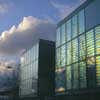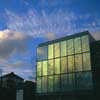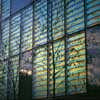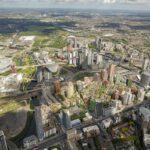Peabody Trust Housing Silvertown, East London Residential Building Project, Photo, Property Design
Silvertown London : Peabody Trust Architecture
Contemporary East London Housing design by Niall McLaughlin Architects
19 Jan 2007
Silvertown Housing
Location: East London
Design: Niall McLaughlin Architects
Fresh Ideas for Low Cost Housing, Silvertown, East London, London
Peabody Trust design competition
In December 2002, we won a design competition organised by the Peabody Trust. It was called Fresh Ideas for Low Cost Housing. The site was in Silvertown in East London, between Royal Victoria Dock and the River Thames. We concentrated on the following design issues:
1. A rational layout of the interior, with a large, flexible living space which has unusually high ceilings for low cost housing.
2. The view from the building, over the strange landscape of the London Docklands: London City Airport, Canary Wharf and the Millennium Dome.
3. The strange chemical history of the site.
4. The nature of modern industrialised construction, in which a timber-frame is wrapped in a decorative outer layer.



photographs © Niall McLaughlin
Each living unit has two bedrooms and a shared bathroom. The kitchen, dining and living functions are accommodated within a single, large space on the south side of the building. This allows each apartment to make the most of the sun and the view. There is a little south-facing terrace outside each flat, and the ground floor units each have a back garden. Special corner windows on the upper floor flats allow the view to open out along the street towards the Millennium Dome and Canary Wharf in the distance.
This practice usually looks carefully into the history and topography of a site. Each location has something comparable to DNA, a coded trace pointing towards the future. Everything from local myths to geology can become a starting point for architecture.
Looked at in the context of historical time, this site experienced an extraordinary flowering of industry from the time of the Great Exhibition in 1851 to the collapse of British manufacturing in the late 1970s. In 1850 the place was marshland, by 1990 it had returned to almost total dereliction.
The industrial flowering, or chemical-flare, lasted for a very brief period of time. Now the area is being repopulated by a rag-bag of yuppie-houses, airports, an IBIS Hotel and a vast conference centre. It is both somewhere and nowhere. This kind of place has been called a post-industrial landscape. We prefer to think of it in the context of emerging and dissolving landscapes. The uncertainty of its identity is the essence of the place. Its properties are fugitive.
Further Info on Silvertown Housing
Even the name Silvertown plays a trick on you. The glister in the name comes from Stephen Winkworth Silver who built a rubber plant on the site in 1852, manufacturing wet-weather clothing. It’s the kind of stuff Queen Victoria might have inspected at the opening of the Great Exhibition the year before. Raw material from the Empire transformed directly into cheap consumer goods on the shore where it landed.
Looking at the map change during the next fifty years, we can see the blooming of a remarkably consistent range of factories making sugar, coloured dyes, jam, golden syrup, gutta percha, soda, TNT, soap and matches. A now surreal photograph from 1900 shows horse-drawn petroleum carts on Knights Road, reminding us of the previous life of this most iridescent of materials. The Victorians, through chemistry and trade, learnt to make luxury cheap. These factories manufactured chemical sweetness, colour and light.
In one bizarre incident, a whale beached herself on the North Woolwich shore in 1899. Was she lost, or was she following her nose towards John Knight’s Primrose Soap Works? The factory workers ran out and stoned or bludgeoned her to death. A photograph shows them standing proudly on her 66-foot carcass. These two emblems of the sublime were clearly incompatible.
The factories lined the river and the warehouses lined the dock. In between lay a zone of industrial worker’s housing. It was low lying, squat and regular. Our site lies on the edge of Evelyn Road. Although the street is partly derelict now, it separated the houses from the warehouses. Our apartments are built on the warehouse side of the street.
Modern low cost housing construction is pre-fabricated timber frame and timber sheeting. We imagined our building being like a row of packing crates stacked up near the water. Once you make the timber carcass, you have to wrap it in something. This is usually a layer of brick, or wood, or tiles.
The industrial product is returned to a reassuring traditional appearance. For our project we looked at kinds of industrial wrapping that might be used as the final layer of our building. Given the site history, we wanted something bright and sweet and chemical. It also had to be inexpensive.
We collaborated with light artist Martin Richman for this project, he suggested a material called Radiant Light Film. It is produced by 3M, who make everything from dental adhesive to post-it-notes. It has dichroic properties so it produces iridescence.
Colourless metal oxides on the surface of the film disrupt the reflection of light, producing interference patterns that appear as colour. As the angle of incidence changes, the colour changes. The surface, the light source and the viewer are in an ever-changing relationship. The 18th Century physicist and architect Auguste Fresnel discovered this effect and explained the phenomenon of iridescence. It appears naturally in petrol and peacocks wings.
The south facade of the building is wrapped in a cladding of dichroic material held in glass frames. These faÁade units have a 200mm depth and contain two groups of offset louvers, the first centred within the depth of the case, and the second on the back wall. The louvers are fabricated from sheet acrylic, each covered in the dichroic film. Light hitting the facade is reflected back from different layers, producing a shifting pattern.
Cast glass captures the light as it escapes. In time, a stand of silver birch trees will add an extra layer to the facade. They will cast shadows onto the surface and catch reflected coloured light. At times the light effect is robustly geometric, at others it is evanescent and fugitive. We want the building to have a dream-like quality as though its image will not fix completely in your mind. We hope that this connects to the shifting, uncertain properties of the place.
This was a Design & Build Contract in which our practice partnered with Sandwood Construction who worked successfully with us on the development of the design, as well as the construction of the building. They gave considerable support in solving the many practical difficulties involved in taking materials that are not standard building products and incorporating them into the face of the building.
The contractor, Sandwood Construction had entered into a framework agreement with the client, the Peabody Trust. We too entered into the sprit of partnering on this project and had a good working relationship with the contractor. The contractor’s were committed to teamwork and were involved in the detail design throughout. This gave the client the confidence that ambitious details could be achieved.
A Design & Build Contract allows the architect less control over the detail as the contractor takes the opportunity to detail many aspects of the design. The responsibility for site inspections also changes, the architect’s responsibilities are lessened as the contractor takes on this responsibility. It is usual for the contractor to employ the architect to continue the design development for such projects.
A typical problem faced on Design & Build contracts is that the budget is fixed. There is no allowance for a contingency sum should unforeseen extras be inevitable. When buried ordnance, munitions and toxic waste were found during the excavations, there was no budget available for dealing with the careful removal needed. Items simply had to be omitted from the work – in this instance it was agreed that it would be the interior radiant light film and rooflights. Such omissions seem brutal for an architect with a strong design vision, but necessary under such a contract.
In order to ensure design control, the architect needs to have worked through and specified all the critical details by the end of the ‘Final Proposal’ stage. Under a traditional contract, many details are deferred until the ‘Production Information’ stage. Under a Design & Build Contract, this would be too late. The circular columns in the corner glazed windows may have been omitted if we as the architects had realised earlier on in the design process and ensured that the roof cantilevered at this point. Under a traditional contract, this change may have been possible, where the fixing of all details early on is not critical.
The insurers who re-insure first time home buyers were unhappy that the faÁade didn’t have the guarantees that building products usually have, as it was not an approved application. The Housing Association needs the insurers approval. We approached 3M, the dichroic film manufacturers, but they were unwilling to advise on it’s suitability for use on a building as the quantities needed were simply too small.
We then employed Dewhurst MacFarlane, glass experts and faÁade designers, who produced a performance specification for the design that embodied the employer’s requirements. It isolated the only potential danger, that the glue fixing the film to the louvres would become embrittled by U-V light. Dewhurst MacFarlane advised that the glass has a U-V filter on it to protect the glue and carried out accelerated testing on the glue to test it’s performance over 30 years.
This process was not fast enough to be complete before work began on site so had to be carried out concurrently. The specification was then changed so that the performance of the faÁade panels was independent of the performance of the building. By so doing, the performance of the glue would not affect the building’s performance. If the glue failed, only the aesthetic appearance of the building would be altered. On this basis, the insurers agreed to provide suitable cover.
The glass panels were developed with the sub-contractor. The initial design was sent to different tenderers who each provided their strategy. Firman Glass, for example created a laminated glass panel. Architectural Aluminium in Dublin were the preferred sub-contractor.
They developed aluminium cases deep enough to contain the film on offset acrylic louvres. The back of the case is polished aluminium and the front is cast glass with a standard double-glazed seal between. The panels, which act as a rainscreen, are clipped onto the timber frame construction behind. Air can circulate freely behind the panel.
At one stage, coloured bands were to be wrapped around the breather membrane, with battens on top and acrylic sheet over to reveal the construction. The problem with this was the potential for dust, condensation and mould to accumulate on the back of the acrylic where it is ventilated. This was not based on any research, but an intuitive detailed response early on in the design process.
Silvertown Housing, East London for Peabody Trust – images / information from Niall McLaughlin Architects 190107
Silvertown Housing design : Niall McLaughlin Architects
Location: Silvertown, East London, England, UK
London Buildings
Contemporary London Architecture
London Architecture Links – chronological list
London Architecture Walking Tours by e-architect
Silvertown Buildings
Contemporary Silvertown Buildings – Selection
Silvertown Quays, East London
Arup / Allford Hall Monaghan Morris
Silvertown Building : Aquarium
Terry Farrell Architects
Southmere Village Library in Thamesmead Competition, UK
Southmere Village Library in Thamesmead Architecture Competition
Buildings / photos for the Silvertown Housing – Low Cost Homes – Peabody Trust Competition page welcome

